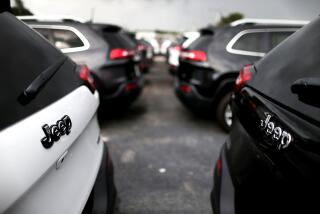Probe blames Boeing and FAA for 787 Dreamliner battery fire
Missteps by Boeing Co. and the Federal Aviation Administration led to a fire aboard a 787 Dreamliner nearly two years ago that was parked at a gate at Boston’s Logan International Airport, national safety officials concluded in a report Monday.
No passengers were aboard the Japan Airlines aircraft when ground workers detected the fire. After a similar battery fire in another Dreamliner two weeks later, the world’s entire fleet of the jets was grounded for almost four months.
The National Transportation Safety Board said that poor design, manufacturing and testing caused the fire in the lithium-ion battery — deficiencies it blamed on Boeing and one of its suppliers. The board also faulted the FAA for failing to identify the design defects.
After a two-year investigation, the board said “the probable cause” of the fire Jan. 7, 2013, was an internal short circuit within a cell of the battery, which then spread to adjacent cells.
Boeing uses the lithium-ion batteries on the Dreamliner because they are small, lightweight and powerful. With the batteries, Boeing was able to swap out heavy hydraulic systems for lighter electronics, which help the Dreamliner burn 20% less fuel than similar-size aircraft.
The company already has redesigned the battery to reduce the risk of overheating and to prevent fire from spreading. The changes include a steel case around the battery and a tube that vents fumes outside the fuselage. In April, the FAA said the Dreamliners were safe to fly.
In Monday’s report, the NTSB said that even with those changes, the batteries’ cells could overheat. The board said the FAA should work with aviation experts to make the batteries safer.
Sales of the Dreamliner have recently been increasing as Boeing has overcome the plane’s long history of manufacturing problems and delays. Richard Aboulafia, an aviation analyst at the Teal Group, said he did not believe the board’s report would hurt Dreamliner sales.
Aboulafia pointed out, however, that the report showed that although Boeing made the plane safer with its changes to the batteries’ design, it never determined what actually caused them to fail.
“There are people who would feel more comfortable if they did a proper root cause analysis,” he said.
The NTSB report also raised questions about Boeing’s decisions to outsource more of its manufacturing to other companies. Boeing contracted with Thales Group, a French firm, for the manufacturing of the plane’s power conversion system. Thales then subcontracted the manufacturing of the battery to GS Yuasa of Japan.
The NTSB concluded that GS Yuasa’s manufacturing process allowed for defects in the battery and that its testing was flawed. The board said that Boeing should provide more oversight of its suppliers, including secondary providers such as GS Yuasa.
Doug Alder, a Boeing spokesman, said the company remains confident in the Dreamliner’s safety.
“We continue to work reliability improvements on the 787 and will do so throughout the span of the program,” he said.
Kenneth Quinn, a spokesperson for GS Yuasa, said newer batteries have design enhancements approved by the FAA.
“We’re always eager to implement continuous quality improvement,” Quinn said, “and will study the board’s findings and recommendations carefully.”
The FAA did not respond to a request for comment.
Twitter: @melodypetersen
More to Read
Inside the business of entertainment
The Wide Shot brings you news, analysis and insights on everything from streaming wars to production — and what it all means for the future.
You may occasionally receive promotional content from the Los Angeles Times.











